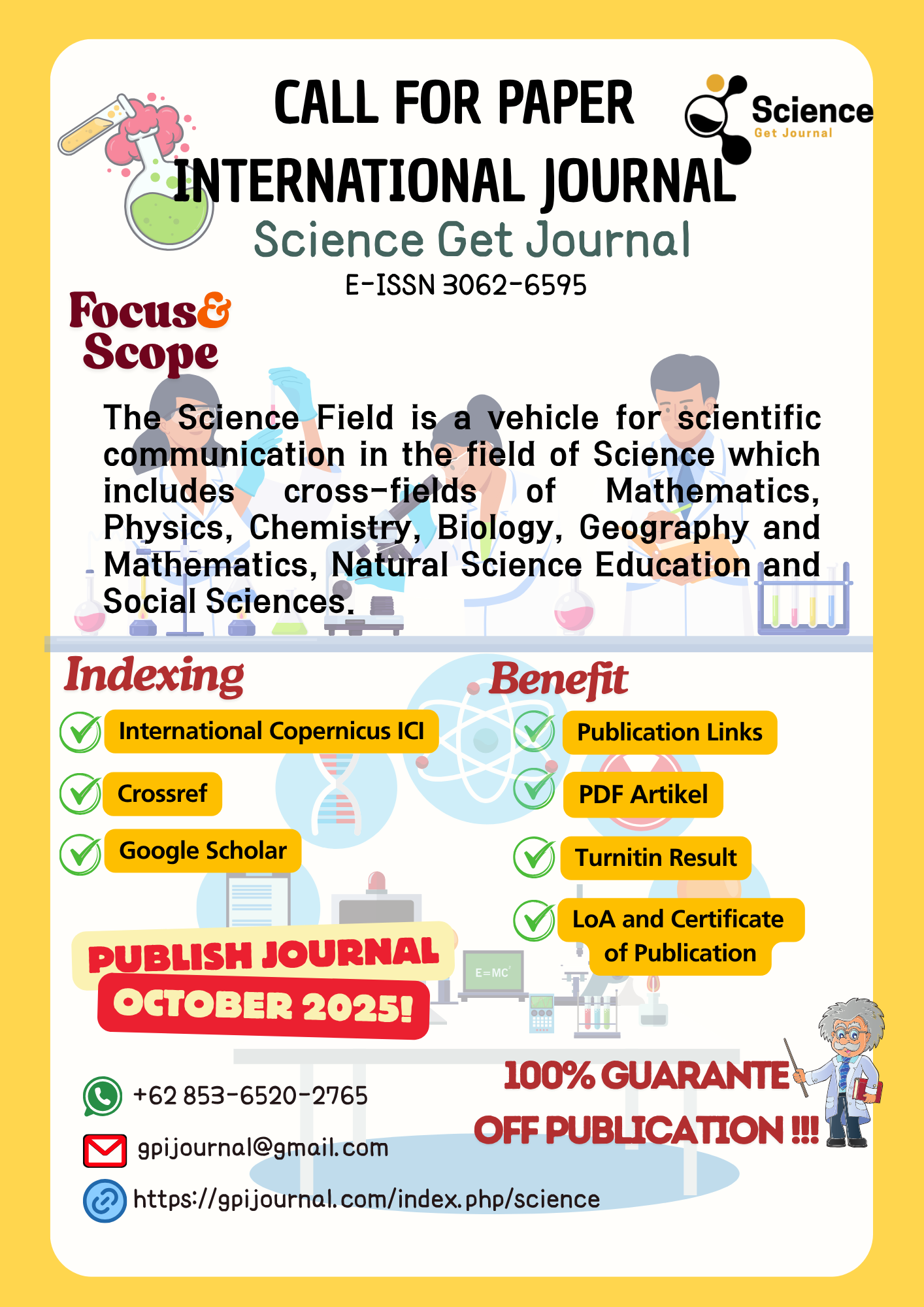Synthesis of Cellulose-Based Nanomaterials Agricultural Waste for Heavy Metal Adsorption in Water Applications
DOI:
https://doi.org/10.69855/science.v2i4.275Keywords:
Nanocellulose, Heavy Metals, Adsorption, Wastewater Treatment, Sustainable Materials, Surface ModificationAbstract
Heavy metal contamination in aquatic systems drives the need for sustainable and high-performance adsorbents. This study developed functionalized nanocellulose materials derived from rice husk waste for efficient removal of Pb(II), Cd(II), Cu(II), and Cr(VI) from aqueous solutions. Cellulose nanocrystals (CNCs) were synthesized via sulfuric acid hydrolysis and functionalized through TEMPO-mediated oxidation to introduce carboxyl groups, while cellulose nanofibrils (CNFs) were modified by ethylenediamine grafting to incorporate amine functionalities. Characterization using FTIR, XRD, and SEM confirmed successful surface modification, reduced crystallinity, and the presence of nanoscale fibrillar morphologies. Batch adsorption studies showed that CNC-TEMPO achieved a maximum adsorption capacity of 189.5 mg/g for Pb(II) and 112.3 mg/g for Cd(II) at pH 5–6, while CNF-Amine exhibited superior performance for Cr(VI) removal with a capacity of 205.5 mg/g at pH 3–4. Kinetic analysis followed a pseudo-second-order model (R² > 0.99), indicating chemisorption as the dominant mechanism, whereas isotherm fitting with the Langmuir model (R² > 0.98) confirmed monolayer adsorption. The enhanced adsorption capacity was attributed to electrostatic interactions and surface complexation between functional groups (–COO⁻, –NH₂) and metal ions. These findings highlight that rice husk–derived, surface-modified nanocellulose provides a low-cost, eco-friendly, and efficient alternative for heavy metal remediation and sustainable wastewater treatment applications.
References
Abdelhamid, H. N. (2024). Nanocellulose‐based materials for water pollutant removal: A review. International Journal of Molecular Sciences, 25(15), 8529. https://doi.org/10.3390/ijms25158529
Barman, S., Bera, S., & Javid, M. (2024). Cellulose-based nanomaterials (nanobioadsorbents) for recovery of valuable metals from wastewater: A review. Current Nanoscience, 20(5), 317–335. https://doi.org/10.2174/1573413719666231109145835
Braz, W. F., Amorim, J. D. P., Oliveira, A. M. C., Mattos, B. D., Pereira, F. V., & Rosa, D. S. (2025). Nanocellulose application for metal adsorption and its perspectives in water treatment. Metals, 15(8), 832. https://doi.org/10.3390/met15080832
De Silva, M., Cao, G., & Tam, K. C. (2025). Nanomaterials for the removal and detection of heavy metals: A review. Environmental Science: Nano. https://doi.org/10.1039/d4en01041h
Gobi, M., Kumar, A., Singh, J., Singh, S., & Ramamurthy, P. (2024). Nanocellulose-based adsorption for the removal of heavy metals from wastewater—A review. Water Conservation Science and Engineering, 9, 24. https://doi.org/10.1007/s41101-024-00197-y
Joshi, N. C., Joshi, A., Mitra, D., & Singh, R. (2024). Removal of heavy metals using cellulose-based materials: A mini-review. Environmental Nanotechnology, Monitoring & Management, 22, 100942. https://doi.org/10.1016/j.enmm.2023.100942
Karzegar, S., Abedi, M., Salmani, M. J., & Rahimi, A. (2024). Modification of agricultural waste carbon adsorbents with iron and iron oxide nanoparticles for heavy metals removal: A review. Journal of Environmental Health and Sustainable Development, 9(4), 17387. https://doi.org/10.1007/s44260-024-00027-7
Kurniawan, T. W., et al. (2023). Cellulose nanocrystals (CNCs) and cellulose nanofibers (CNFs) as adsorbents: Synthesis, modification, and heavy metal removal. Journal of Nanomaterials, 2023, 5037027. https://doi.org/10.1155/2023/5037027
Li, J., Sun, Y., Li, Q., Chen, B., & Zhang, H. (2022). Aminated cellulose nanocrystals for enhanced adsorption of hexavalent chromium from aqueous solutions. ACS Sustainable Chemistry & Engineering, 10(15), 4980–4992. https://doi.org/10.1021/acssuschemeng.1c08375
Mazibuko, M. T., Ochieng, A., & Chirwa, E. (2024). Amine-functionalized cellulose-silica composites for Cr(VI) adsorption. Journal of Environmental Chemical Engineering, 12(2), 110647. https://doi.org/10.1016/j.jece.2024.110647
Pandey, A., Kalamdhad, A. S., & Sharma, Y. C. (2023). Recent advances of nanocellulose as biobased adsorbent for heavy metal ions removal: A sustainable approach integrating with waste management. Environmental Nanotechnology, Monitoring & Management, 20, 100791. https://doi.org/10.1016/j.enmm.2022.100791
Sayyed, A. J., Pinjari, D. V., Sonawane, S. H., Bhanvase, B. A., & Shirsath, S. R. (2021). Cellulose-based nanomaterials for water and wastewater treatments: A review. Journal of Environmental Chemical Engineering, 9(6), 106626. https://doi.org/10.1016/j.jece.2021.106626
Si, R., Jiang, S., Jiang, H., & Wu, C. (2022). Nanocellulose-based adsorbents for heavy metal ion removal. Polymers, 14(1), 116. https://doi.org/10.3390/polym14010116
Xu, Q., Liu, C., Jiang, L., Huang, L., & Chen, W. (2021). Enhancing removal of Cr(VI), Pb(II), and Cu(II) from water by amino-modified nanocellulose. Environmental Science and Pollution Research, 28, 23050–23063. https://doi.org/10.1007/s11356-020-12058-7
Yu, K., Wang, Y., Li, X., & Zhao, J. (2025). Nanocellulose-based aerogels for the adsorption and removal of heavy-metal ions: Recent advances. Journal of Environmental Chemical Engineering. https://doi.org/10.1016/j.jece.2025.110998
Zeng, W., Luo, Y., & Wang, C. (2025). A review on recent advances of adsorption and photoreduction of Cr(VI) in aqueous solutions: Insights on material properties and process parameters. Journal of Environmental Chemical Engineering, 13(1), 110332. https://doi.org/10.1016/j.jece.2024.110332
Zhan, C., Sharma, P. R., He, H., Sharma, S. K., McClements, D. J., & Hsiao, B. S. (2020). Rice husk-based nanocellulose scaffolds for highly efficient removal of heavy metal ions from contaminated water. Environmental Science: Water Research & Technology, 6(11), 3080–3090. https://doi.org/10.1039/d0ew00435f
Downloads
Published
How to Cite
Issue
Section
License
Copyright (c) 2025 Suhdi, Setiarto Pratigto

This work is licensed under a Creative Commons Attribution 4.0 International License.





